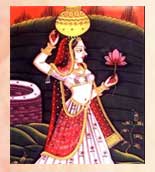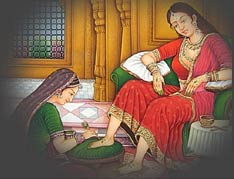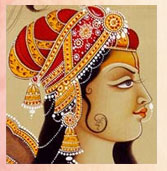Home >
Arts > Paintings > Silk Paintings
Silk Paintings are very much a unique way to create a charming sense of aura that is the impression of the painting. In India the style of silk painting emphasizes more on the softness, elegance and a flexibility of the design. Silk is very much diligently used as a canvas for portraits and paintings. Skilled Indian artists have made and are making use of a process that allows the silk canvas to be kept on "hold" the paint in vibrant way which exhibits the details for the design.

Silk paintings can be designed as art which can be hanged, or which are functional, such as wearable art or for home decor. In these paintings the heavy use of gold appears as another distinguishing characteristic to highlight the patterns of the silk and imbibes in it various other uses of materials.
The characteristics of Silk Paintings usually depict the rich court life, epics and religious themesof ancient India. These paintings often make use of gold, glitters, gemstones, etc.
Silk Paintings can be classified into the following.

• Animal Paintings
• Bird Paintings
• Village Paintings
• Indian Epic Paintings
• Religious Paintings
Historically the Silk painting as a form of art originated from Europe and has been gradually gaining momentum in India. Silk being a very comfortable and flexible fabric has become more available than before. Painters have taken keen interest in Silk Paintings as an art form owing to the French serti technique of applying the dye to the silk. The advantage of making a silk painting would be that it is easy and clean while the end result is a beautiful silk painting piece.

Silk paintings are popularly known for their positive attributes of movement and fluidity which would make it a sign of a hallmark.
The colors which are used by the painters glide through the silk very comfortably and help in generating a fusion of colors.
The methods which should be followed while making a silk painting:

• The traditional silk painting dyes have certain characteristics of movement. Techniques that are used to create the art of silk paintings are resist, shading, gradation, watercolor, hard edge, salting and spotting with water/alcohol.
• To start up creating the silk painting, the fabric firstly is stretched on a wooden frame while the design is being resisted.
• Once the fabric gets painted then the silk is allowed to dry and then later it can be steamed to give permanent dyes to the fibers.
• The fabric is then later rinsed, ironed and ready to be used.
Silk painters usually add a unique dimension to the silk painting with the right tones of colors, shading and other surface techniques. Their main challenge is to vary the effects on the surface. Silk painters usually make use of salt, alcohol effects, wet-on-wet treatment, wet-on-dry painting, etc.
In Indian art and craft, Silk paintings are applied on miniature paintings using delicate brushes where the fabric is silk. The contemporary paintings like the ragmalas or melody garland which is very much an exclusive style of Indian paintings. Silk paintings are available as individual pieces of framed art, stoles or clothes. They are magnificent and have been known to be a rich source of art work in the Indian and global context.


